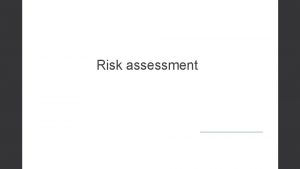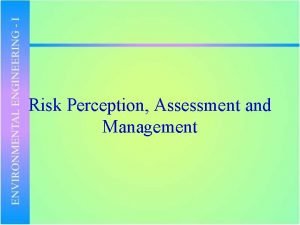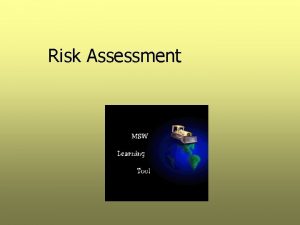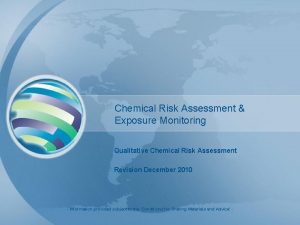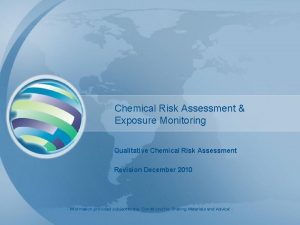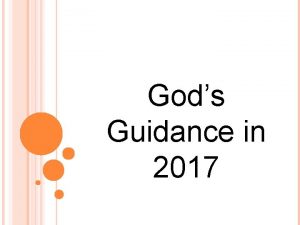Chemical Risk Assessment Guidance for each chemical prior

















- Slides: 17

Chemical Risk Assessment Guidance for each chemical (prior to purchase)

This section should be completed prior to purchasing any chemicals, you will need the safety data sheet in order to complete it. Chemical name as it appears on the SDS sheet This concentration of the chemical you are purchasing The CAS-number is a unique number for each compound. Mixtures may have more than 1 CAS-Number. See SDS, section 3. This should be the largest volume container you are purchasing (grams, Kg, millilitres, litres etc). Campus, building and room number where the chemical will be stored Potentially unstable chemicals will have special storage requirements and an expiry date, after this date they may become unsafe. (E. g. some ethers can form explosive peroxides when stored for prolonged periods). See chemical label / certificate of analysis. (Further information about stability is also in the SDS section 10). The sheet should be reviewed, then updated if necessary or when a new purchase is made

Section 2 SDS Identify which hazard symbols are present , check the boxes Danger – most severe Warning – less serious Use the drop-down menu to list all the hazard codes and hazard statements. An * next to a hazard statement indicates it is a category 1 carcinogen, a mutagen or asthmagen. The hazard groups will be automatically identified. See Section 8 SDS or EH 40. Work Exposure Limits (WELS) are legal limits that must not be exceeded. If the chemical is category 1 carcinogen, a mutagen or asthmagen, you MUST consider substituting this chemical with a safer alternative.

The hazard codes listed above will help you to assign the chemical to the highest hazard group for: • skin and eyes • Inhalation When you do your risk assessment, this will help you to consider the route of entry and select controls that are proportionate to the health risk. Identify if the chemical can be a hazard for pregnant or breastfeeding parent. This is not where you consider if any new or expectant parents are present.

See section 9 SDS Drop-down list: is the chemical in pellet, granular, dust, liquid. If it is a liquid, record the boiling point Flash Point should be recorded (if available) Auto ignition temperature should be recorded (if available)

estates-waste@swansea. ac. uk SDS, Section 8. If PPE is required, you MUST ensure that suitable PPE is available prior to starting work. PPE manufacturers & suppliers can advise on PPE selection. Complete this section if standard PPE will be inadequate. SDS, Section 7 & 10. You MUST ensure you have suitable storage facilities and space available prior to purchasing the chemical. Incompatible chemicals must be stored apart. Flammable liquids must be stored in a locked flameproof cabinet. Section 13 SDS. Waste disposal guidance is available from https: //staff. swansea. ac. uk/pro fessional-services/estates-andfacilities-management/ourservices/sustainability/waste/ . If you are unsure, please contact your Environment Officer or Estates. Waste@swansea. ac. uk

Prepare for emergencies: ensure you know what to do if there is a first aid accident, fire, spill or other foreseeable emergency. Ensure that suitable equipment is readily available; and that you are trained to deal with these emergencies or know how to summon trained help. Do not just cut and paste from an sds. This information must be readily available when you use the chemical. SDS, Section 4 – You must ensure all necessary equipment is in place before purchasing the chemical (e. g. diphoterine, eye wash, first aid kit). If you are unsure, please contact your H&S Lead. SDS, Section 5 – You must ensure all necessary equipment is in place before purchasing the chemical. If you are unsure, please contact H&S Lead. SDS, Section 6 – You must ensure all necessary equipment is in place before purchasing the chemical (e. g. correct spill kit / PPE / detection tubes). If you are unsure, please contact H&S or Environment Officer

Is the chemical listed as an ozone depleting substance or fluorinated gas? If so you will need to consider if any alternatives can be used. If not you must follow University guidance to ensure legal and internal reporting requirements are met. Please contact your Environment Officer

Chemical Activity Risk Assessment

This is an example Safe Operating Procedure (SOP). The SOP should be produced by using the risk assessment / equipment manual, task observations etc. and is a step by step guide on how to complete the activity • Before starting work you will need to break down your task / method into small steps, to systematically identify the hazards. • Then identify the controls needed in each step to reduce the risks; this is to protect your health and safety - and the H&S of other people who may be affected by your work. • You will also need plan for emergencies and know how to dispose of your waste safely.

This document will summarise the risk to health, safety and the environment. Complete a row for each chemical used in your experiment. The first 4 columns will be taken from your chemical information sheets. Other factors that will affect your risk.

Other factors that will affect your risk. You may prefer to give exact quantities as a record of your experiment.

Campus, building and room number Give as much detail as possible as the to the nature of the activity These can be the chemical information sheets, there could be more than one per activity, SOP’s for the activity these can include safe handling, storing using of all chemicals, lab rules etc. Date risk assessment is completed. This should be before any work has started. The assessor (s) should be competent and understand the proposed activity The assessment should be reviewed in the event of a change in process or chemicals, as a result of an accident / incident or periodically (normally annually)

Use to hierarchy of control to reduce the risk:

This should include any supervision required for all involved in the activity e. g. close supervision of inexperienced users or young people. E. g. supervision of undergrads (Number of staff and demonstrator to student ratio) etc. . Identify the training required to carry out this activity safely. This should include any training required e. g. lab induction, training in SOP’s, training in the use of equipment, mandatory training e. g. compressed gas training etc. It must reflect the facilities available. Users / emergency responders must be trained. Check waste guidance for appropriate waste disposal and ensure arrangements are in place prior to starting work.

Exposure monitoring is a way of measuring the extent of e. g. dust or noise levels during a specific task. It may be required • when detecting a failure or deterioration of a control measure which could cause a serious health effect • making sure exposure limits are not exceeded. • Checking on the effectiveness of control Contact your College H&S Lead if you require further information about exposure monitoring. Health surveillance is a system of ongoing health checks. These health checks may be required by law for employees who are exposed to noise or vibration, ionising radiation, solvents, fumes, dusts, biological agents and other substances hazardous to health, or work in compressed air. Health surveillance is important for: • detecting ill-health effects at an early stage, so employers can introduce better controls to prevent them getting worse • highlighting lapses in workplace control measures, therefore providing invaluable feedback to the risk assessment If you are unsure and/or if required, please contact college H&S lead because you must ensure adequate resource and measures are in place prior to work starting.

• A general risk assessment should be completed for the activity this identifies: • All other hazards that may be present e. g. fire, explosion, compressed gases, cryogenic liquids, use of equipment e. g. centrifuge. • Who might be harmed • What measures are already in place • Any additional measures to manage the risk A specific DSEAR risk assessment may need to be carried out
 Draw rmmm plan
Draw rmmm plan Market risk assessment
Market risk assessment Balanced occlusion definition
Balanced occlusion definition Indirect guidance
Indirect guidance Iso 22301 utbildning
Iso 22301 utbildning Novell typiska drag
Novell typiska drag Nationell inriktning för artificiell intelligens
Nationell inriktning för artificiell intelligens Returpilarna
Returpilarna Varför kallas perioden 1918-1939 för mellankrigstiden?
Varför kallas perioden 1918-1939 för mellankrigstiden? En lathund för arbete med kontinuitetshantering
En lathund för arbete med kontinuitetshantering Särskild löneskatt för pensionskostnader
Särskild löneskatt för pensionskostnader Tidböcker
Tidböcker Sura för anatom
Sura för anatom Förklara densitet för barn
Förklara densitet för barn Datorkunskap för nybörjare
Datorkunskap för nybörjare Boverket ka
Boverket ka Mall för debattartikel
Mall för debattartikel Delegerande ledarskap
Delegerande ledarskap



















